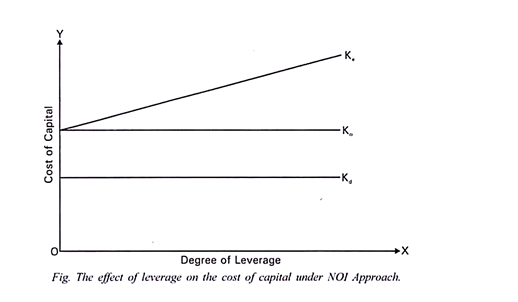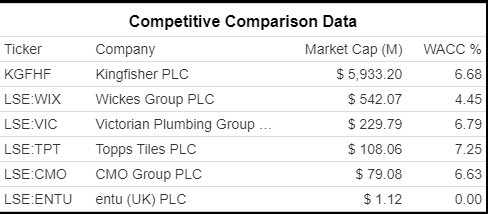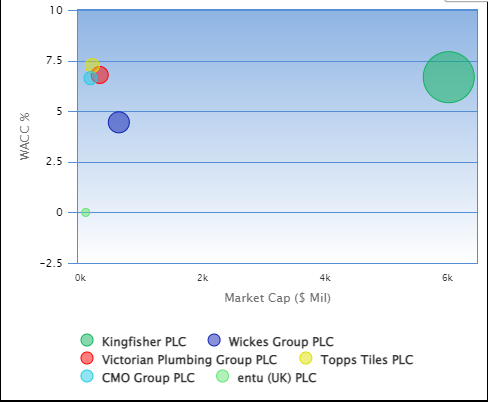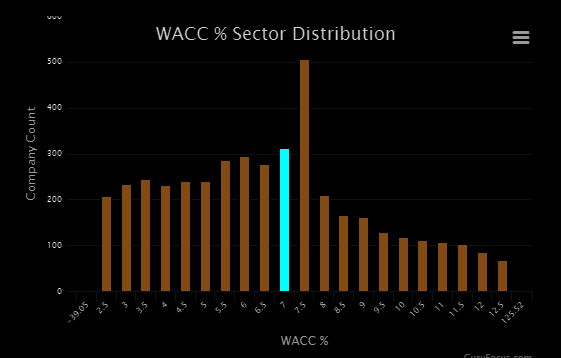Capital Structure and Weighted Average Cost Of Capital
As per the lectures, capital structure is recognized as a definite mix of equity and debt that is utilized in financing a company’s operations and assets. The weighted average cost of capital (WACC) refers to a company’s calculation of the cost of capital, whereby there is a proportionate weight in every category of capital. A company’s capital structure is therefore expressed as debt to capital ratio/ debt to equity ratio (Zhao, 2018). The capital information theories comprise the information costs theories, such as the Signalling and the Pecking order theory, the agency, trade-off, and contracting theories, all of which are viable in ascertaining financial business performance.
Net Operating Income Approach
Durand suggested that the Net Operating Income (NOI) means that there exists irrelevance in the firm’s decision on a capital structure. A firm’s market value is not affected by the change incurred in the capital structure (Zhao, 2018). Irrespective of the ways of financing, the overall cost remains constant.

The above figure shows a graphical explanation of the NOI approach. The diagram shows a degree of leverage on the X-axis. The cost of equity (Ke) presents the percentage rates, the overall cost of capital (Ko) is plotted on the Y-axis and the Kd shows the cost of debt.
Modigliani and Miller Approach (MM Approach)
This theory was named after two professors who studied the theory of capital structure Franco Modigliani and Merton Miller in the 1950s. Two propositions of the theories were, first, the capital structure is not relevant to the value of the firm. There is a similarity between MM approach to the Net Operating Income theory as both involve ignored taxes. When no taxes are incurred, a firm’s value is dependent on future earnings. This means that two identical firms would have the same value and would not be affected by the finance used on the assets. As per the second proposition, information on tax is available when there is a boost in the value of a firm due to financial leverage and that has led to a reduction in the WACC.
The hypothesis that is provided by the MM theory is similar to that of the Net operating income approach. As per the two theories, when there are no taxes are incurred, the market value of a company and its capital cost remains invariant to the changes in the capital structures. Additionally, the two professors who came up with the MM theory did not support the existence of the optimal capital structure but rather supported the NOT theory.
The Trade-off Theory (TOT)
As per this theory, the determination of corporate leverage is attained by balancing the debt benefits attained from the tax savings against the bankruptcy deadweight costs. TOT was first used in 1984 by Myers in providing the description of the perspective of the tax bankruptcy (Agyei et al., 2020). According to TOT, the structure of some form of optimal capital should be existing pursuant to the balance between the cost of bankruptcy and the currently prevailing value of the interest tax shields.
Trade-off theory is applicable in making predictions that are applicable in the business world. Firstly, according to TOT, firms will get target debt ratios that will be different among various firms. Secondly, TOT firms with relatively more tangible assets will be allowed to borrow more and they will not be exposed to financial distress. As per the third prediction, higher levels of leverage will be associated with higher rates of marginal tax. This has been triggered by the tax deductibility of the interests. Lastly, firms with low non-debt tax shields and more taxable income will generally have more incentives to borrow.
Pecking Order Theory
Pecking Order Theory (POT) is primarily focused on asymmetrical information costs. When firms utilize this theory, their financing strategy is based on the path of least resistance (Frank et al., 2020). Similar to POT, the TOT is recognized as among the influential theories of firms’ capital structure. When the two theories are compared, it is found that when both are applied, POT is not applicable in the prediction of the optimal capital structure as TOT is. Additionally, POT is based on the explanation of why debt ratios have got variances, this is as opposed to the strategy laid down by the static TOT that is based on the target adjustment model (Rahman, 2019). The POT, therefore can be rejected when the adjustment is specified or when the financing flows with the target while the TOT will likely lead to the creation of reverting debt ratios.
An FTSE 100 (Kingfisher PLC) Companies
Kingfisher plc (KGF) is a recognized market leader in the UK and Europe; the company needs to constantly evaluate its financial strategy and capital structure to maintain its position in the market. The company’s capital structure can be calculated in two ways, that is, capital gearing and the Weighted Average Cost of Capital. In the comparison, the gearing levels are compared against the sector using two competitors are utilized, the Home Retail Group and Travis Perkins.
Capital Gearing
The gearing ratio refers to the measure of the financial risks and the expression of the debt that a company has in terms of equity. Firms that have greater capital gearing are known to have huge debts that are relative to their value of equity. One method used in the calculation of the KGF gearing ratios is the division of the long-term debt by the shareholder’s funds.
- Formula that is to be used is the = long – term debt / (Shareholder funds + long-term debt).
- Formula for all borrowings = All borrowing / (All borrowings +shareholder).
Most of the individuals who are prone to using this include investors, analysts, and researchers. The current borrowing at KGF entails the finance leases, overdrafts, and loans from the bank that total £2.225M (Silva, 2020). Additionally, for the financial status of a company to be ascertained, KGF versus sector has to be relied on. Through it, we are able to determine whether the company is at risk or not. A business that has a higher risk usually has got a low financial risk due to its less debt.
According to KGF plc 2020-2021 annual report, the capital gearing ratio for the past three years (Kingfisher plc, 2021).
- Common stock equity 2018/19 was 6,149
- 2019/20 was 5,802
- 2020/21 was 6,571
- Fixed Interest-bearing funds were; 2018/19 = (5,698)
- 2019/20 = (6,111)
- 2020/21 = (6,320)
- Capital Gearing Ratio = Common Stockholders’ Equity / Fixed Interest-bearing funds.
- Capital Gearing Ratio 2018/19 = 6,149/(5,698) = 1.07
- Capital Gearing Ratio 2019/20 = 5,802/(6,111) = 0.94
- Capital Gearing Ratio 2020/2021 = 6,571/(6,320) = 1.03

Kingfishers Weighted Average Cost of Capital
Cost of Equity
The financing equity of KGF has got only ordinary shares, this means that calculating the cost of the equity, can be done through dividend growth or the Capital Asset Pricing Model (CAMP). CAMP model when applied, it accounts for the unsystematic and systematic risks that are involved in the calculation. The unsystematic risk that is recognized as specific can be evaded through diversification, while systematic risks are usually difficult to reduce. KGF plc 2017 stopped transactions on some of its ordinary shares. Additionally, for the past three years, KGF has had a low relative level of debt-to-equity ratio.
CAMP and formulae Rf+Bj*(Rf-Rm) are created through a combination of the various risks formulated and combined. The calculation of the Rf is determined through the estimation of the government bond. Rf of the Bank of England as provided on the website is at 2.80%. The return on the market (Rm) (Rm-Rf) average stands at 5% (Silva, 2020). Since Beta is recognized as the risk of the business that can be compared to the market that is 1 (falling within the recommended risk range). According to the KGF plc 2020-2021 annual report, the Cost of the Equity can therefore be calculated as
CAMP = 2.80% + 0.96*5% = 7.60%.
WACC
The interest rate for every specific borrowing can be taken as the cost of debt (Kd). There is a specific corporate tax that the interest rates need. Kd will then be determined by multiplying the interest rate by 0.68; after that the resultant is multiplied against the weight of the debt. To get the weighted average cost from Ke, the value of Ke is multiplied by the weighting of the equity and in some circumstances, each resultant value can be added together.
WACC = Market Value of Equity/Total Value of Financing × Cost of Equity + Market Value of Debt/Total Value of Financing × Cost of Debt × (1-Tax Rate)
E/(E+D) = 0.6
Cost of equity = 9%
D/(E+D) = 0.4
Cost of Debt = 6%
Tax rate = 19%
0.6*9+0.4*6*(1-19/100) = 7.34%



References
Agyei, J., Sun, S., & Abrokwah, E. (2020). Trade-off theory versus pecking order theory: Ghanaian evidence. SAGE Open, 10(3), 2158244020940987.
Frank, M. Z., Goyal, V. K., & Shen, T. (2020). The pecking order theory of capital structure: Where do we stand?
Kingfisher plc (2021). Kingfisher plc 2020-21 Annual Report & Accounts.
Rahman, M. T. (2019). Testing trade-off and pecking order theories of capital structure: Evidence and arguments. International Journal of Economics and Financial Issues, 9(5), 63.
Silva, F. M. D. D. (2020). Equity research-Kingfisher PLC (Doctoral dissertation, Instituto Superior de Economia e Gestão).
Zhao, L. (2018). Literature review of capital structure theory and influencing factors. Modern Economy, 9(10), 1644.
